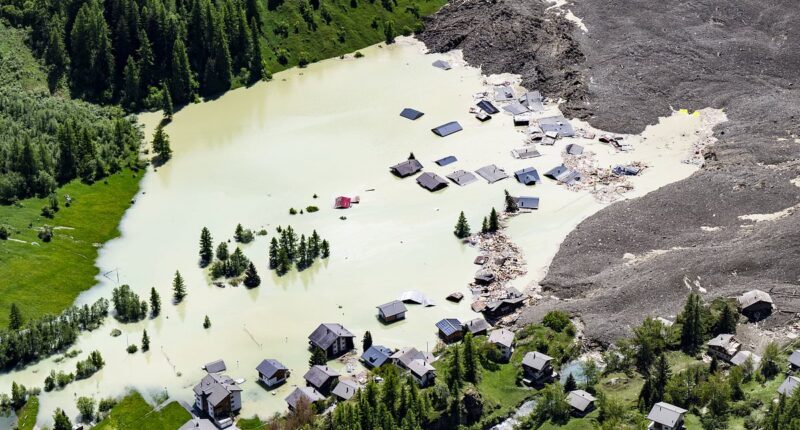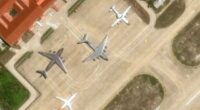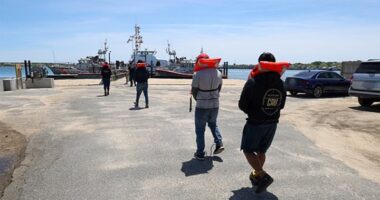
At least two more Swiss villages are under threat of being wiped out by floodwaters after one hamlet was almost completely buried under millions of tonnes of debris following a glacial collapse.
A chunk of the Birch glacier in Switzerland’s southern Valais region broke off yesterday, sending a torrent of rock, ice, and scree hurtling down the mountain slope and into the valley below.
Horrifying video footage showed a huge cloud of dust rising over the village of Blatten as the oncoming rubble dwarfed Alpine lodges before burying them entirely.
The population of some 300 villagers were evacuated in advance, but 90% of the town is now lost to the mountain of debris – and authorities have said one person remains missing.
Now, a new peril is brewing as officials warned the landslide had blocked the river Lonza, effectively creating a dam that could burst at any moment.
‘There is a serious risk of an ice jam that could flood the valley below,’ Antoine Jacquod, a military security official, told the Keystone-ATS news agency.
Residents of two downriver villages, Kippel and Wiler, have been evacuated as a precaution as authorities contemplate issuing wider evacuation orders.
New images shot from a helicopter above Blatten lay bare the scale of the destruction – and the likelihood that its neighbouring settlements could face a deluge.
‘It’s like a mountain, and of course, it creates a small lake that gets bigger and bigger,’ explained Raphael Mayoraz, the cantonal official in charge of natural hazard management.
Meanwhile, the Valais cantonal government has asked the Swiss army to provide clearing equipment and pumps to secure the riverbed.
‘The deposit… is not very stable, and debris flow is possible within the deposit itself, making any intervention in the disaster area impossible for the time being,’ cantonal authorities stated, adding there was risk on both sides of the valley.
As authorities work to avoid another catastrophe, officials and residents of Blatten told of their horror following the disaster that erased their livelihoods.
‘The unimaginable has happened,’ Blatten’s president Matthias Bellwald told a press conference yesterday. ‘We have lost our village, but not our hearts.’
‘Even though the village lies under a huge pile of rubble, we know where our homes and our church must be rebuilt,’ he added.
Stephane Ganzer, the head of security in the southern Valais region, told local TV channel Canal 9 that the army had been mobilised to deal with the fallout.
The glacier collapse had been expected for several days, and most were able to evacuate earlier this week.
But ‘the worst-case scenario has occurred,’ Mayoraz said.
He said three million cubic metres of material had accumulated on the glacier, and then tumbled down into the valley towards homes.
‘An unbelievable amount of material thundered down into the valley,’ said Matthias Ebener, a spokesperson for local authorities in the southwestern canton of Valais.
Drone footage shown by national broadcaster SRF showed a vast plain of mud and soil completely covering part of the village and the river running through it.
The disaster occurred at around 3:30pm local time on Wednesday when a huge chunk of the Birch glacier broke off.
Local police said the missing 64-year-old man was a local resident who was in the area at the time of the incident.
A search and rescue operation was launched, with three specialists airlifted to the scene, while a drone with a thermal imaging camera was also used.
‘Despite significant efforts, the man has still not been found,’ police said.
The command staff in Blatten now assumes that the entire village has been destroyed, according to Blick.
They suggest the houses that are still standing have since been flooded.
Experts consulted by Reuters said it was difficult to assess the extent to which rising temperatures spurred by climate change had triggered the collapse because of the role the crumbling mountainside had played.
Christian Huggel, a professor of environment and climate at the University of Zurich, said while various factors were at play in Blatten, it was known that local permafrost had been affected by warmer temperatures in the Alps.
The loss of permafrost can negatively affect the stability of the mountain rock which is why climate change had likely played a part in the deluge, Huggel said.
The extent of the damage to Blatten had no precedent in the Swiss Alps in the current or previous century, he added.
Several aid organisations have responded in the wake of the disaster.
Caritas Switzerland and the Swiss Red Cross (SRC) provided the equivalent of €430,000 for uncovered damages, according to Kurier.
The Sponsorship for Mountain Communities (SPAM) in Blatten also plans to provide more than €1 million in relief.
Swiss glaciers, severely impacted by climate change, melted as much in 2022 and 2023 as between 1960 and 1990, losing in total about 10 percent of their volume.
The amount of snow covering Switzerland’s glaciers at the end of winter this year was 13 percent below the 2010-2020 average, a group of glacier monitoring experts said earlier in May.
It comes after hundreds were evacuated from the Alpine village in southern Switzerland amid fears of an imminent rockslide.
Many feared they would never see their homes again as experts revealed 1.5 million cubic metres of had already tumbled down the mountainside.
Last Monday, some 200,000 cubic metres of rock descended down the mountain face, with the situation having stabilised by the next day.
Alban Brigger, a natural hazards engineer in Upper Valais, was even more stark in his warning last week – that the mountain is certain to collapse.
He added however that this event could potentially happen over several, smaller landscapes, rather than a widescale collapse that would obliterate the hamlet and nearby roads.
In 2023, residents of the village of Brienz in eastern Switzerland were evacuated before a huge mass of rock slid down a mountainside, stopping just short of the settlement.
Brienz was evacuated again last year because of the threat of a further rockslide.
Swiss President Karin Keller-Sutter expressed her solidarity with the local population as emergency services warned people the area was hazardous and urged them to stay away, closing off the main road into the valley.
‘It’s terrible to lose your home,’ Keller-Sutter said on X.
The devastating glacier collapse comes days after five skiers were found dead on a glacier above a popular Swiss winter sports resort.
A helicopter was sent to survey the area around Rimpfischhorn, a 4,000-meter peak in the Valais Alps near the town of Zermatt on Sunday, after two hikers reported seeing abandoned skis.
Valais cantonal police revealed the victims were located on the Adler Glacier at varying altitudes on avalanche debris.
Air rescue service Air Zermatt said three bodies were located together in one area with rescue teams discovering the other two victims on a higher, narrower patch of snow the BBC reported.
Formal identification of the victims is ongoing and their nationalities have yet to be released.
The Rimpfischhorn is a 4,199-metre (13,776-foot) mountain that lies east of Zermatt, near the Italian border, and is popular with backcountry skiers.

















